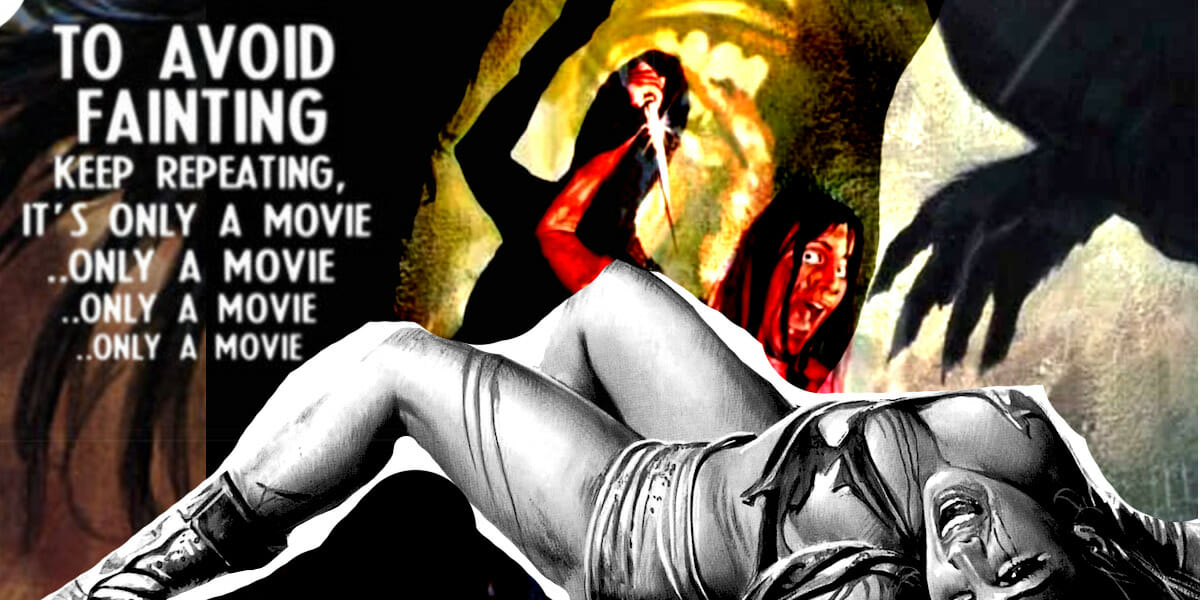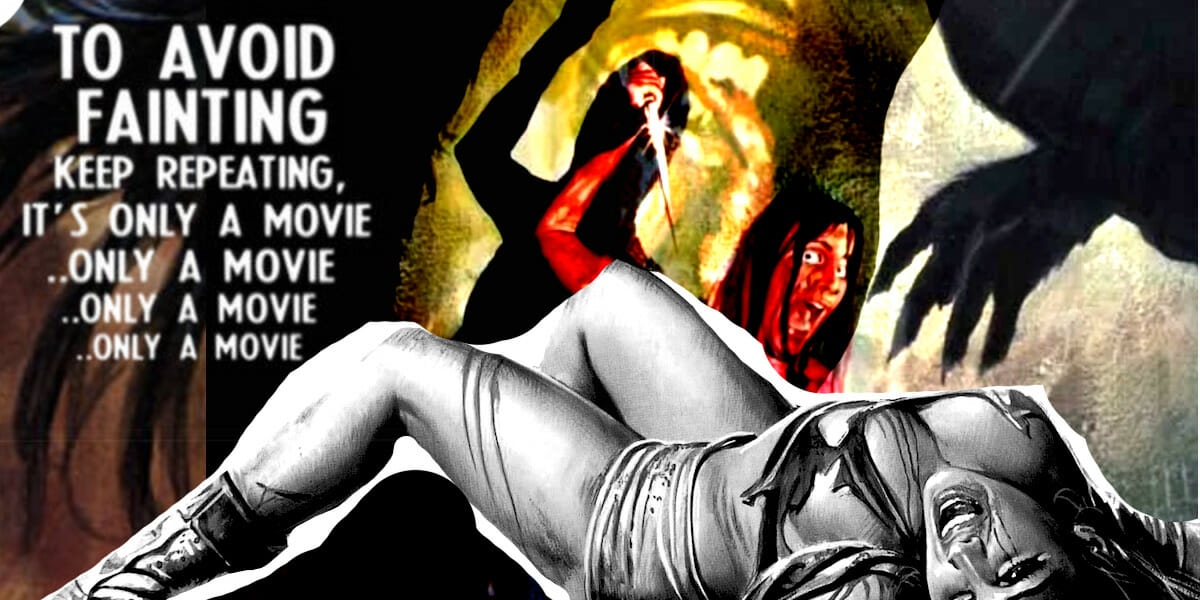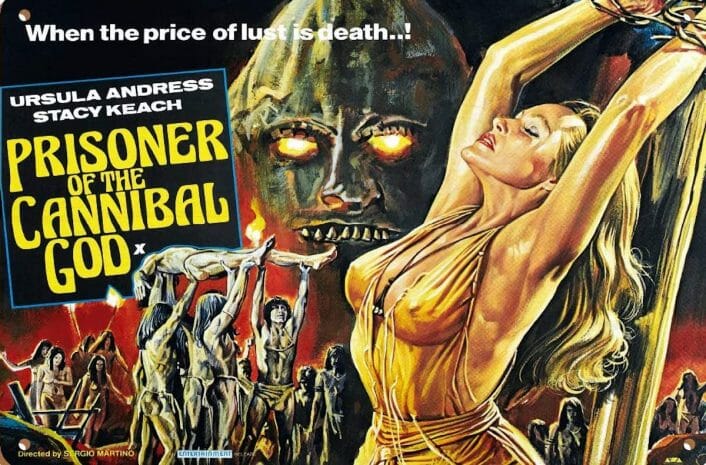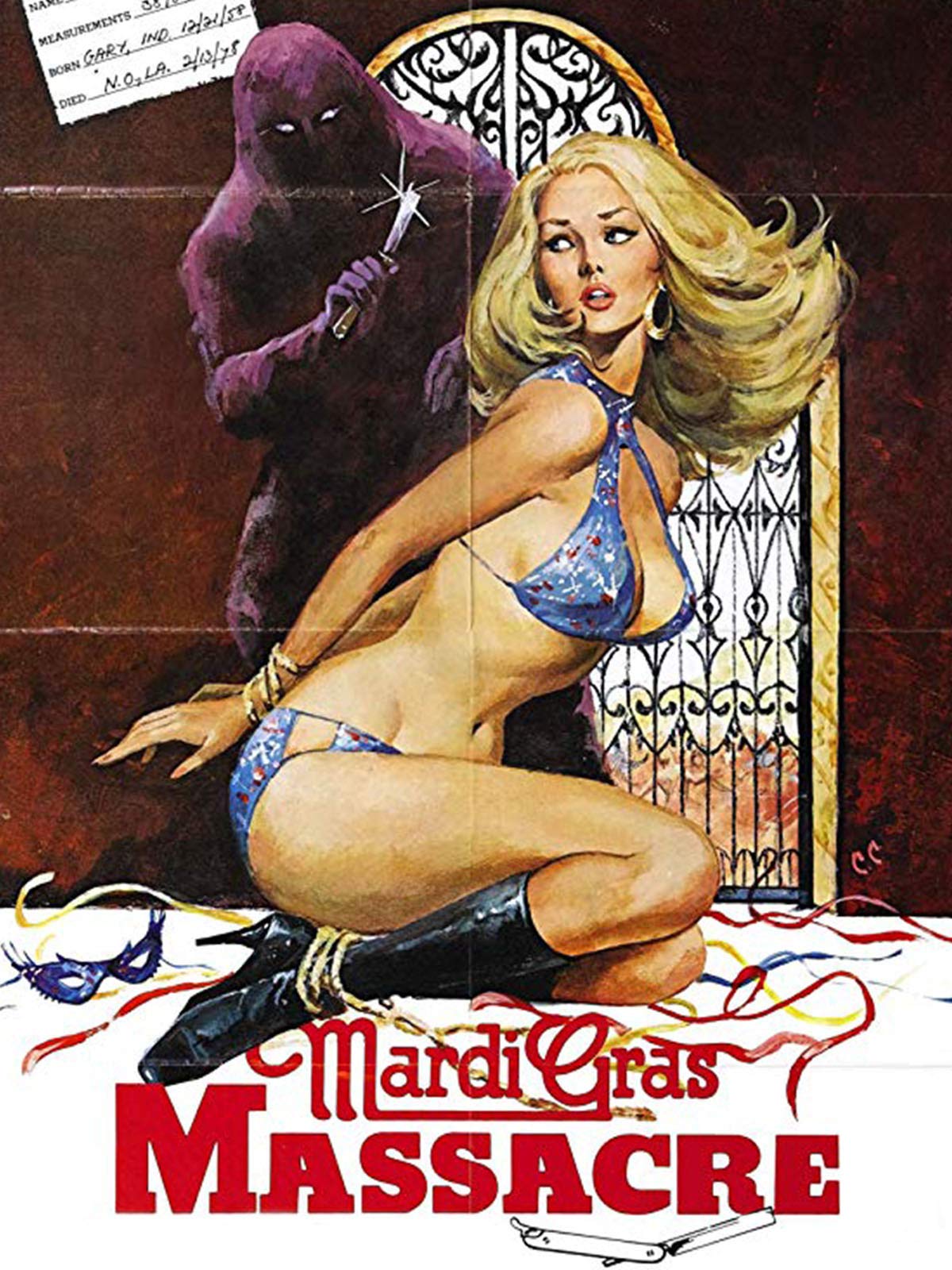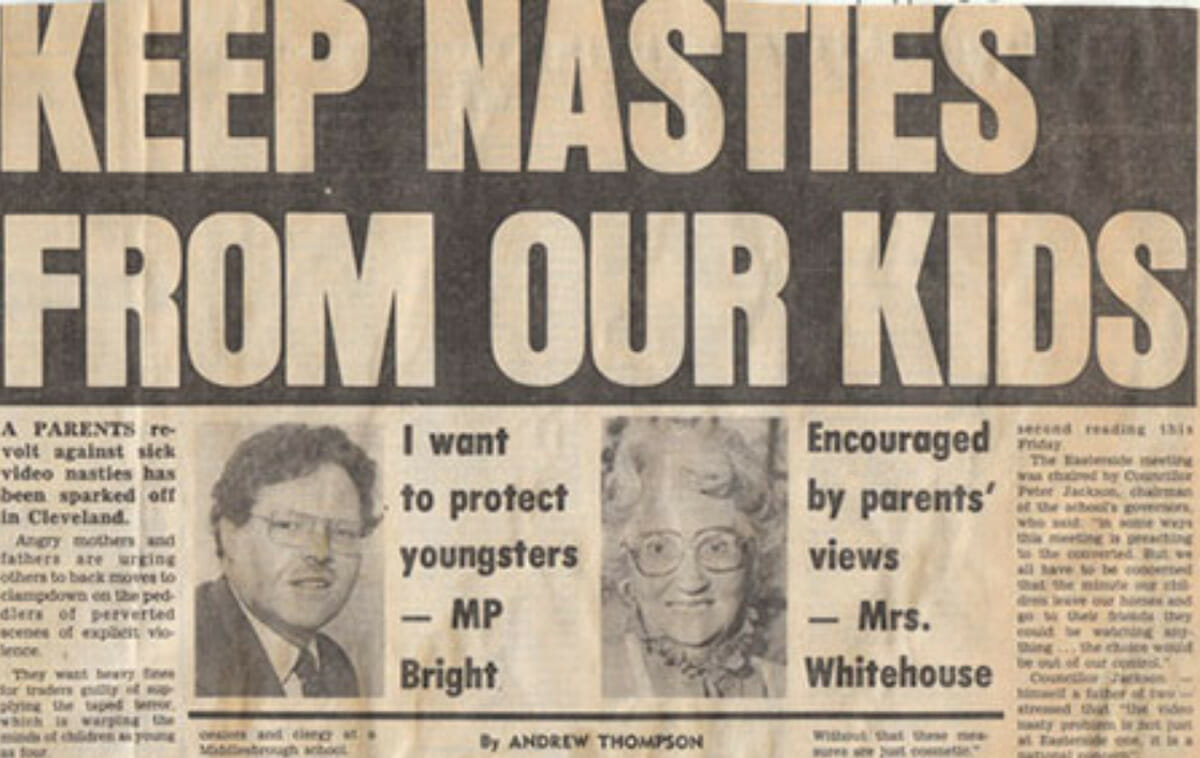British video stores in the early 1980’s were scary places to be. It’s where Amazonian cannibals and flesh eating zombies liked to hang out with driller killers and over-sexed Nazi’s. If you got really lucky, you might catch a glimpse of a killer nun. Slashers, splatters, and demons filled the shelves as swathes of foreign sex and gore dominated the fledgling British VHS market.
As Hollywood dilly-dallied—unsure whether to embrace or fight against home video—households on both sides of the Atlantic were purchasing home video players in large quantities creating a consumer demand not met by the mainstream. This absence of studio distribution allowed independent companies to run the show; a feat which entertainment entrepreneurs quickly seized upon as an opportunity to import video tapes of previously unavailable 70’s gore and slasher movies to a bloodthirsty UK market. With no cable or satellite TV in Britain, video culture was pounced upon and devoured like the cast of Cannibal Holocaust. Across the country, teenagers were zapping popcorn and sitting down to watch Zombie Creeping Flesh or Prisoner of the Cannibal God —fingers excitedly placed over the pause and rewind buttons.
Knowing they were on to a winning formula, distribution companies such as Vipco marketed their exploitation movies with increasingly lurid and explicit artwork in order to entice an increasingly insatiable young audience. And why not? After all, nobody seemed to be paying attention to what was on the video shelf. The British film censors who tightly marshalled British cinemas were oddly absent from the video realm.
In fact, at the outset, video had no regulatory body at all. This unexpected loophole meant horror fans could gain access to the forbidden fruit of 1970’s horror. Wes Craven’s Last House on the Left, and Mario Bava’s A Bay of Blood, both denied a theatrical release in the UK, were now being stocked on the video shelf at the local grocery stores. Italian giallo and US slashers nestled next amongst cauliflower and tinned soup in shopping baskets.
Film censorship laws differ in the UK to America. Whilst the Motion Picture Association of America (often shortened to MPAA) is, in effect, a voluntary organisation whose ratings are crucial to the economic success of a movie, but not a legal requirement, a rating from the British Board Film Classification is mandatory and necessitated by law. Any movie which fails to gain BBFC approval cannot legally be sold or distributed in the UK. As such, unrated movies simply don’t exist in the UK. But for a while in the early 80’s, there was a legal lacuna—an uncensored, unregulated, exploitation wilderness, where cannibals, zombies and driller killers were allowed to roam free.
Sadly, it didn’t last long. The outlandishly provocative artwork and taglines promoting exploitation videos drew the attention of those consumers unhappy by having to choose between Mardi Gras Massacre or SS Experiment Camp to watch with Friday night supper. News of complaints to the ASA (Advertising Standards Agency) began to circulate in the press. Tabloid newspapers began to blame exploitation videos for a decline in moral standards.
In no time at all, Britain had been whipped into a moral frenzy as politicians and christian campaigners reiterated the narrative appearing below headlines such as ‘Ban Video Sadism Now’ and ‘The Rape of our Childrens Minds’. The first inclusion of the term ‘video nasty’ came in the Sunday Times in 1982. As film critic Mark Kermode wrote in his 1995 essay ‘Horror: On the Edge of Taste, “horror videos were promptly blamed for everything from inattentiveness at school to muggings and rape, with headmasters, clergymen and politicians calling for drastic measures to protect the country from video dealers.’
At the centre of the ‘video nasty’ debate was the contention that video, by definition, presented a risk to children. As video was in the home, children of any age might possibly be exposed to images of extreme sex and violence. The often repeated yet totally unfounded newspaper claim was that ‘four in ten six year olds watch video nasties’. It was a statistic that stoked fear in the British psyche and turned the ‘video nasty’ scandal into a full blown ‘moral panic’. Stanley Cohen’s classic sociology text, Folk Devils and Moral Panic, analysed the way British media overreacted to the Mods and Rockers movement in the 1970’s, creating an over-inflated sense of moral outrage in the British public. According to Cohen, moral panics occur when “a condition, episode, person or group of persons emerges to become defined as a threat to societal values and interests.”
For Margaret Thatcher and the Conservative government, with a reputation for being bastions of moral rectitude and family values, something needed to be done. With no specific legislation to control or censor video content in place, the only way exploitation movies could be banned was by implementing the Obscene Publications Act with the Director for Public Prosecutions tasked with curating a list of titles which would direct police to seize and destroy videos alongside hefty fines and potential prison sentences to any guilty video dealer, dubbed the ‘Merchants of Menace’ by the British press.
An official list of 72 ‘video nasties’ was drawn up and in typical British fashion, a series of cock ups and bungled operations by the police ensued. Without enough copies of the list, the boys in blue carried out some on the spot censorship. They confiscated copies of Dolly Parton-Burt Reynolds musical The Best Little Whorehouse in Texas, and, more bizarrely, Lee Marvin’s war movie The Big Red One; and Sidney Lumet’s Deathtrap was confused with Tobe Hooper’s Texas Chainsaw Massacre follow up Death Trap. Most titles added to the list were there purely because of their title or cover artwork rather than the actual content. Sam Raimi’s The Evil Dead and Dario Argento’s Tenebrae had been passed by the BBFC and given theatrical releases in the UK, yet the very same versions were deemed obscene by the DPP. Discussions continue as to how courtroom drama I Miss You, Hugs and Kisses, made it on there.
In the wake of a landslide election victory, Thatcher’s Conservative government hastily passed legislation to put an end to the matter once and for all. The Video Recordings Act 1984 put video in the legal arms of the BBFC, aligning video and cinema governance. The censors believed pause and rewind functions on video, as well as its place in the family home was sufficient reason to place tighter restrictions on video than the ‘safe space’ of a cinema. By this time an increasingly corporate and respectable video market had begun to receive a supply of blockbusters from Hollywood and the ‘video nasty’ was indeed vanquished.
But whilst no longer being found on video store shelves, the newly illicit movies on the DPP’s ‘video nasty’ list immediately acquired cult status. Rather than going away, horror fans began sourcing and sharing bootleg copies, forming an underground community of subversive cinefiles and a thriving horror network. Writer Kim Newman was one of those fans. In a recent edition of Sight and Sound, he says that “inevitably, the DPP list was used by horror fans like the i-SPY book of garden birds – there was competition to see who could see and tick off all the films.”
Viewers were often left disappointed when it turned out most movies on the list were not the gore-tastic, sex laden romps the cover sleeve suggested. Far from being video nasties, movies like Evil Speak and Frozen Scream were quite tame, and often terrible. Not quite so tame but equally terrible is I Spit On Your Grave, acclaimed as a cult classic by some, this is a rape revenge story more interested in rape than revenge, and justifies the video nasty label.
But amongst the dross is a worthy selection of intelligent cinema which far from warranting ‘video nasty’ status, should be recognized as quality filmmaking. One example is Abel Fererra’s The Driller Killer. This was the movie most cited in the British press during the video nasty scandal. The explicitly violent images used to advertise The Driller Killer first prompted members of the public to write and complain. In many ways it was the movie that came to define the term ‘video nasty.’ To my mind however, The Driller Killer is anything but a ‘video nasty’. It is a tender portrayal of the creative process that wrestles with the role of art in contemporary society.
Reno is The Driller Killer, a struggling New York artist played by Ferrera himself. Attempting to finish a painting he hopes will ease the struggle of poverty, Reno rents a run down Manhattan loft studio, with his bisexual girlfriend and her female partner. Intermittently shot with documentary footage of homeless alcoholics, swigging from brown bags and vomiting in the street, Reno is both frustrated and appalled by the destitution of his surroundings. His attempts to finish his masterpiece – a giant portrait of a buffalo whose intense stare seems to mesmerize – are further hampered when a New Wave punk band, ‘Tony Coca-Cola and The Roosters’ start rehearsing upstairs. Reno’s failure to finish the painting whilst surrounded by incessant noise and squalor, places him in a societally induced psychosis. He buys a drill from a hardware store and takes to the streets late at night, attacking the homeless and disaffected; fueled by anger, resentment, and a fear that he may one day end up just as hopeless as they are.
There are few scenes of violence in The Driller Killer and Reno’s deranged forays into the maddened New York streets that are often carried out in absurd, comedic ways. One attempt by Reno to snare his next victim is choreographed like a Tom and Jerry chase sequence, offering more slapstick than splatter. Reno chases a downtrodden, confused wino up and down the street. Caught behind a pillar, they peek from one side then the other, like children playing a game of tag.
The scuzzy, low budget aesthetic of The Driller Killer brings an honesty and tenderness to the film, making it veer into being something closer to arthouse than grindhouse. There are no lingering shots or close ups of the actual drilling, no serious gore or body horror to speak of. Instead of blood and guts, the movie chooses to focus on ritualistic artist endeavour, such as when The Roosters argue over how best to pronounce ‘oop-sha-dooby’. Reno’s girlfriend, Carol, decides she’s had enough and leaves for her old, more affluent life. Reno chases her through the streets knocking her suitcase to the ground. Clutching spilled clothes, he caringly screams at Carol as she descends into the subway, “what about your stuff, baby you need your stuff”.
The character of Reno was based on Ferrera’s artist friend, D.A.Metrov, who plays Tony Coca-Cola in the film and granted Ferrera permission to shoot it in his studio, using his oil paintings. The Driller Killer questions if art and beauty can succeed in a decaying, squalid society. What turns Reno crazy might be a buffalo, or punk rock, or the tarnished streets. Either way, British audiences were starved of its qualities for too long with The Driller Killer not making it back onto the shelves until 1999.
One unintended consequence of the ‘video nasty’ list was that it gave prominence to a number of films which might otherwise have sunk without a trace. The spectacular visual style of Dario Argento’s Tenebrae, or the depiction of a crumbling marriage in Zulawski’s Possession were discovered by film fans due to their notoriety as ‘video nasties’. British film director Prano Bailey-Bond’s directorial debut Censor (2021) is set during the video nasty scandal. Despite being too young to remember it, being a self respecting horror fan, she watched all the films on the list. Not just a blacklist, it was a checklist for many. Matt Cimber’s The Witch Who Came From The Sea (1976) is often cited as the finest film on the list. Kermode says “perhaps The Witch Who Came From The Sea can be seen as the DPP’s gift to horror fans- the good that came from all this madness; the film we would never have seen otherwise.”
The video nasty era continues to intrigue and inspire current generations of filmmakers. Alongside Bailey-Bond’s Censor, Seth Rogen is set to produce ‘Video Nasty’, a tale of teenagers pulled inside an 80’s slasher movie. There is deep rooted nostalgia in the UK for a time when camp and silly 70’s gore was judged responsible for the woes of a nation. It was a time when independent video retailers thrived and outsider communities bonded over a shared passion. Kim Newman remembers it fondly: “In our memory, there is always a corner of some forgotten high street video rental outlet that will remain the haunt of cannibals and fiends and bloody apes and the SS and driller killers, a shelf that is forever nasty.”
